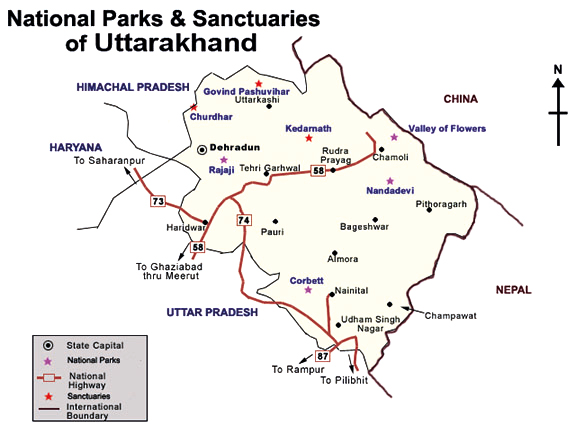Corbett Tiger Reserve: Uttarakhand | 03 Oct 2022
Why in News?
Over 6,000 trees were illegally cut for the proposed Pakhro tiger safari project in Corbett Tiger Reserve (CTR), according to a report of the Forest Survey of India (FSI).
- The FSI has come up with an observation that the area cleared under CTR is estimated as 16.21 hectare (hac) for the Safari Project.
- Pakhro tiger safari will be spread over an area of 106 hectares, when completed, it would have been the State’s first tiger safari that would have tigers in enclosures to ensure “100% sighting”.
What are the Key Points of Corbett Tiger Reserve?
- About:
- It is located in the Nainital district of Uttarakhand. The Project Tiger was launched in 1973 in Corbett National Park (first National Park of India), which is part of Corbett Tiger Reserve.
- The national park was established in 1936 as Hailey National Park to protect the endangered Bengal tiger.
- It is named after Jim Corbett who played a key role in its establishment.
- The core area forms the Corbett National Park while the buffer contains reserve forests as well as the Sonanadi Wildlife Sanctuary.
- The entire area of the reserve is mountainous and falls in the Shivalik and Outer Himalaya geological provinces.
- Ramganga, Sonanadi, Mandal, Palain and Kosi are the major rivers flowing through the Reserve.
- Sprawling over 500 square kilometres, CTR is home to 230 tigers and has the world’s highest tiger density — at 14 tigers per hundred square kilometres.
- It is located in the Nainital district of Uttarakhand. The Project Tiger was launched in 1973 in Corbett National Park (first National Park of India), which is part of Corbett Tiger Reserve.
- Flora:
- Dense moist deciduous forests are found. According to the botanical survey of India, Corbett has 600 species of plants - trees, shrubs, ferns, grass, climbers, herbs, and bamboo. Sal, Khair, and Sissoo are the most visible trees found in Corbett.
- Fauna:
- Apart from tigers, Corbett also has leopards. Other mammals such as jungle cats, barking deer, spotted deer, sambar deer, sloth etc. are also found there.
- Other Major Protected Areas of Uttarakhand:
- Nanda Devi National Park.
- Valley of Flowers National Park.
- Valley of Flowers National Park and Nanda Devi National Park together are a UNESCO World Heritage Site.
- Rajaji National Park.
- Gangotri National Park.
- Govind National Park.
UPSC Civil Services Examination Previous Year Question (PYQ)
Q. Consider the following pairs: (2013)
National Park River flowing through the Park
- Corbett National Park : Ganga
- Kaziranga National Park : Manas
- Silent Valley National Park : Kaveri
Which of the above pairs is/are correctly matched?
(a) 1 and 2
(b) 3 only
(c) 1 and 3
(d) None
Ans: (d)
Exp:
- Jim Corbett National Park: River Ramganga, a tributary of river Ganga is the primary source of water for the park. Tributaries of Ramganga are Khoh, Kolhu and Mandal rivers. Hence, pair 1 is not correctly matched.
- Kaziranga National Park: It is a park hosting around two-third of total world’s one-horned rhinoceros and is circumscribed by the Brahmaputra River. The Brahmaputra forms the northern and eastern boundaries of it, whereas the Mora Diphlu forms the southern boundary. Other notable rivers within the park are the Diphlu and Mora Dhansiri. Hence, pair 2 is not correctly matched.
- Silent Valley National Park: Located in Kerala, the park’s entire stretch drains from north to south by River Kuntipuzha. It is part of the Nilgiri Biosphere Reserve. Hence, pair 3 is not correctly matched.
- Therefore, option (d) is the correct answer.
Q. Among the following Tiger Reserves, which one has the largest area under “Critical Tiger Habitat”? (2020)
(a) Corbett
(b) Ranthambore
(c) Nagarjunasagar-Srisailam
(d) Sundarbans
Ans: (c)
Exp:
- Critical Tiger Habitats (CTH), also known as core areas of tiger reserves, are identified under the Wild Life Protection Act, 1972 based on scientific evidence that “such areas are required to be kept as inviolative for the purpose of tiger conservation, without affecting the rights of the Scheduled Tribes or such other forest dwellers”.
- The CTHs are notified by the state government in consultation with the expert committee constituted for the purpose.
- Area of the Core/Critical Tiger Habitat
- Corbett (Uttarakhand): 821.99 sq. Kms
- Ranthambore (Rajasthan): 1113.36 sq. Kms
- Sundarbans (West Bengal): 1699.62 sq. Kms
- Nagarjunsagar Srisailam (part of Andhra Pradesh): 2595.72 sq. Kms
- Therefore, option (c) is the correct answer.

